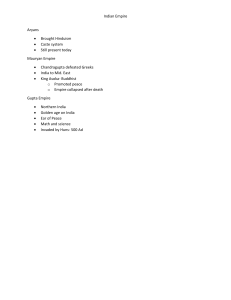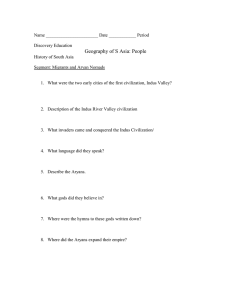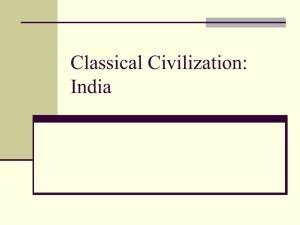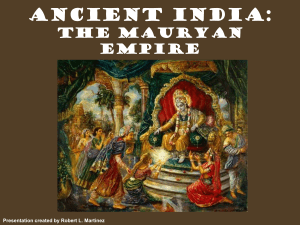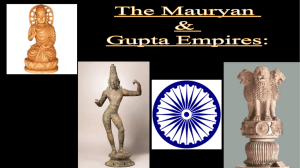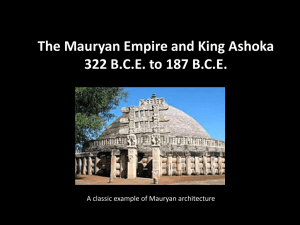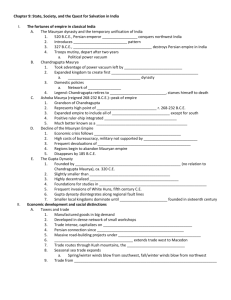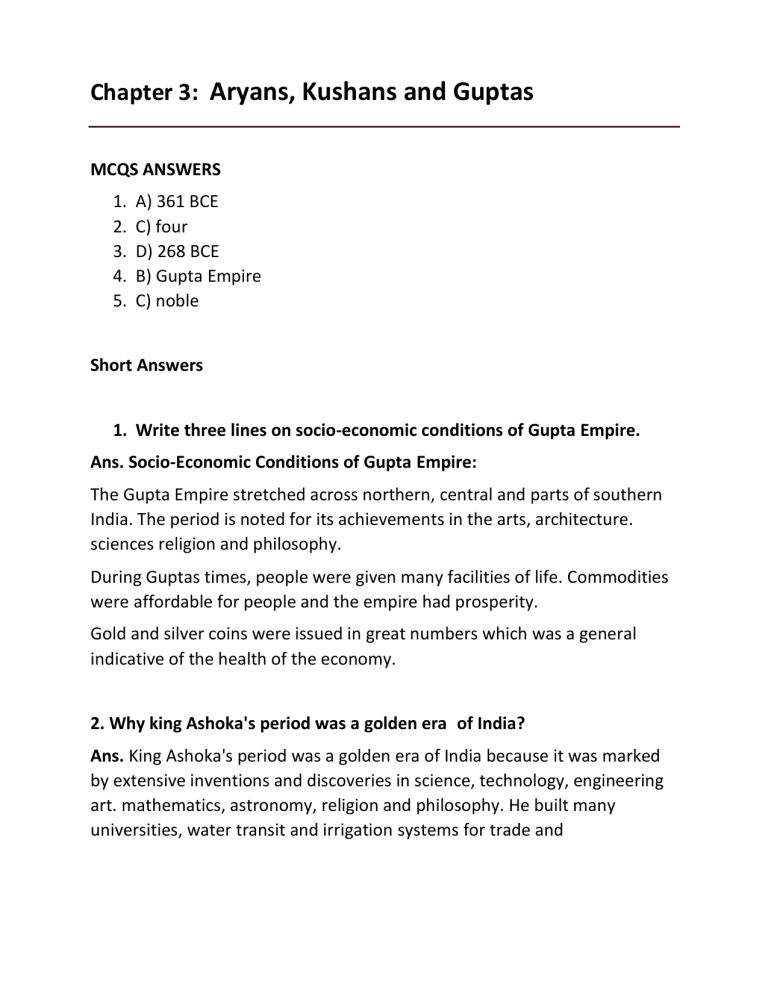
Chapter 3: Aryans, Kushans and Guptas MCQS ANSWERS 1. 2. 3. 4. 5. A) 361 BCE C) four D) 268 BCE B) Gupta Empire C) noble Short Answers 1. Write three lines on socio-economic conditions of Gupta Empire. Ans. Socio-Economic Conditions of Gupta Empire: The Gupta Empire stretched across northern, central and parts of southern India. The period is noted for its achievements in the arts, architecture. sciences religion and philosophy. During Guptas times, people were given many facilities of life. Commodities were affordable for people and the empire had prosperity. Gold and silver coins were issued in great numbers which was a general indicative of the health of the economy. 2. Why king Ashoka's period was a golden era of India? Ans. King Ashoka's period was a golden era of India because it was marked by extensive inventions and discoveries in science, technology, engineering art. mathematics, astronomy, religion and philosophy. He built many universities, water transit and irrigation systems for trade and agriculture. He treated his subjects as equals, regardless of their religion, politics, and caste. He was also acclaimed for constructing hospitals for: animals and renovating major roads throughout India. iii. Who was the first ruler of the Gupta Empire? Ans. The first ruler of the Gupta Empire was Chandragupta-1. iv. What was the main source of Aryan's wealth? Ans. The main occupation of Aryan was cattle rearing. They raised sheep. goats and cattle, which became symbols of wealth. V. Which war changed the mind of Ashoka the Great? Ans. The battle of kalinga changed the mind of Ashoka the Great. Answer the following in details. i. Analyze the structure of the Aryan society. Ans. Structure of the Aryan society: The Aryans developed a system of social classes known as the caste system. Under this caste system. Aryans divided people into four castes, or groups, according to their culture. The caste system was very important aspect of life in Ancient India. People were born into their caste for life. Their caste membership determined the work they did, the man or woman they could marry, and the people with whom they could eat. There were four primary castes: 1. The Brahmins: The highest caste in the Aryan caste system was the Brahmins. Brahmins were priests, scholars, judges, teachers, and landowners and were believed to understand the Dharma, or spiritual laws that governed the universe. 2 2. The Kshatriyas: The second caste included the Kshatriyas who were the rulers and warriors. They made everyday decisions and ran the Government. They were kings, generals, soldiers, and their families. The whole society counted on them for guidance and protection. 3. The Vaishyas: The third caste was the peasants, farmers and traders called Vaishyas. Sometimes Vaishyas had some leadership postions in smaller villages. This was a practical caste composed of crafts people, traders, merchants, and farmers. They had the important jobs of growing food and keeping the society's economy running smoothly. 4. The Shudras: The last caste was the labourers known as Shudras. They worked on farms owned by people in higher castes. Unlike the other three castes the Shudras were not Aryan by blood. Therefore, they were the servants and labourers for the Brahmins, Kshatriyas, and Vaishyas. ii. Describe the origin of the Aryans. Ans. Origin of the Aryans: After the decline of the Indus Valley Civilization, another glorious civilization flourished in India: The people who were responsible for the evolution of this civilization called themselves Aryans. Aryan is an English word derived from the term Arya, meaning "Noble" or "Lord". In the 19th century, the term was often used. The term was often used. The term has also been used to refer to a "race", originally in the sense of a distinet population. The Aryans were a migratory group of people from Central Asia. They indentified themselves a "superior race" They conquered lands to spread their culture and civilization. They describe themselves as a group of free, noble, and civilized people. The Aryans comprised of quite different physical and cultural features. Before the time of the Artan megration to India there was a highly developed evilization in Ancient India known as the Indus Valley | Civilization. 3 iii. Discuss on the rise and contribution of the Mauryan Dynasty. Ans. Rise and contribution of the Mauryan Dynasty: 1. The Mauryan Empire was the first major empire in the history of India form 322 BCE to 185 BCE 2. Chandragupta Maurya established the Mauryan Empire by overthrowing the Nanda Dynasty expanded the empire with the help of his royal and advisor Chanakya. 3. By 316 BCE, the Mauryan Empire fully riccupied north western parts of India, defeating the governors left by Alexander the Great. Chandragupta Mauryan defeated Seleucus 1. the founder of the Seleucid Empire. He gained the territories beyond the Indus River. After Chandragupta Maurya, his son Bindusara started to rule from 297 BCE, Bindusara conquered the southern parts of India. After his death only Kalinga (modern Orissa) and parts of Tamil Nadu were left unconquered. iv. Describe the king Ashoka's life and achievements. Ans. King Ashoka's Life and Achievements: King Ashoka, son of Bindusara became the emperor of Mauryan Empire in 268 BCE. Ashoka the Great, was one of the greatest emperors of the Indian subcontinent. On ascending the throne. Ashoka expanded his empire to regions in Iran. Persia and Afghanistan over the next eight years. The battle of Kalinga changed his life forever. Kalinga was a rich and fertile land. This was the only land left to conquer. The people of Kalinga refused to bow down to Ashoka's rule, however, they were also no match for Ashoka's army. It is said that in this battle thousands 4 soldiers lost their lives an many civilians who rose up in defence were deported. After his conquest. Ashoka, while walking through the grounds, saw burnt houses and scattered corpses which made him sad. • This was the war that changed the mind of Ashoka the Great Ashoka devoted the rest of his life for public services. He became a Buddhist after this war. King Ashoka made many Rock edicts and Stupas in his empire. v. Write a note on religious belief system of the Aryans. Ans. Religious belief system of the Aryans: Aryans religion was very simple. After arriving in South Asia, they accepted some beliefs from the local people.They started worshipping anything as a god. In their religious books Vedas, hundreds of gods are mentioned. There are four Vedas: The Rig Veda, the Sama Veda, the Yajur Veca, and the Atharva Veda. Their famous gods were different gods like Sun. stars, fire, water, and Earth, etc. They had no buildings to perform religious rituals, hence, they prayed at the open. They sacrificed for meat, lentils, milk and other items to please their gods. Gods and their Roles: Indra: Brings rain, thunder and storms Agni: Mediator between gods and men Varuna: Upholder of the natural orders Soma: Sacred drink Prithvi: Goddess of Earth Aditi: Goddess of Eternity Usha: Goddess of Dawn Savitri: Goddess of Sun 5 vi. Compare the social structure of Guptas and Kushans dynasties. Ans. Comparison between social structure of Guptas and Kushans dynasties. Guptas Dynasty it formed in the beginning of the fourth century. The Gupta Empire was Founded by Chandragupta-I They introduced gold and silver coins. Trade and commerce lourished both within the country and outside. Hinduism flourished. Their People were divided into caste system. Their agricultural system was well developed. Kushans Dynasty It formed in the early Ist century common era. Kujula Kadphises laid the foundation of the Kushans Empire in India. They introduced gold coins. Trade prospered between India and China, and India and the Roman Empire Buddhism flourished and brought to china Their people belonged to nomadic tribes. Farming developed. An extensive irrigation economy was created. vii. Analyze the Kushans era. Ans. The Kushans Era: During the Kushans time, diplomatic contacts with the Roman Empire, Sassanid Persia, Aksumite Empire, and Han China were improved. The Kushans linked the seagoing trade of the Indian Ocean with the commerce of the Silk Road, via the Indus Valley. 6 They introduced gold coins. The provided security that encouraged travel across the Khunjerab Pass. They also facilitated the spread of Buddhism to China. The Kushans are believed to have been predominantly practitioners of Zoroastrianism, one of the world's oldest monotheistic religions. Kushans also adopted aspects of Buddhist culture and, like the Egyptians, absorbed remnants of the Greek culture of the Hellenistic Kingdoms. Trade prospered between India and China, and India and the Roman Empire. The Kushans Controlled large parts of the Silk Route which led to the propagation of Buddhism into China. It was during this time that Buddhism began to spread to Korea and Japan also. During the Kushans time, three distinct schools of art flourished: Gandhara, School in north west India. Amaravati School in Anchra and the Mathura School in the Ganges valley Many towers, Chaityas, towns and beautiful sculptures were built under the patronage of the kushana kings. Critical Thinking Questions: Why Ashoka was not known as the ruler of Ancient India for a long time? Ans . Bindusara conquered the southern parts of India. After his death only Kalinga (modern Orissa) and parts of Tamil Nadu were left unconquered. King Ashoka, son of Bindusara became the emperor of Mauryan Empire in 268 BCE. Mauryan King: The small amount of land left to conquer. Kalinga, that was soon conquerred. After his conquest. Ashoka. while walking through the grounds, saw burnt houses and Scattered corpses which made him sad. All this changed the mind of Ashoka. He left rest of his life for public services. Along with a conversion to Buddhism. Ashoka began to promote ideas of tolerance, respect and good will. His actions did not seem to be that of a 7 power hungry tyrant but rather a servant of the empire performing his duties, that is why Ashoka was not known as the ruler of ancient India for a long time. What are the links between Gandhari Art and the Kushans? Ans. Links Between Gandhara Art and the Kushans: The Kushan Empire was first formed in the early Ist century common Era. It was in eastern and northern Afghanistan and the north west of India. During the Kushans time three distinct schools of art flourished. Gandhara School in north west India. Amaravati School in Andhra and the Mathura school in the Ganges Valley. Gandhara School of art was influenced by Buddhism. The Kushans facilitated the spread of Buddhism to China. The Gandhara art flourished under the Kushan Empire. The Gandhara School of art was profoundly influenced by Greek methodologies. The figures of Buddha were more spiritual and carved mainly in grey and bluish-grey colour with the finest details. Infact, the diversity which can be seen through the Kushan Empire is evident in the Gandhara art as well. What are the problems of barter system? Ans. Barter System: The direct exchange of one commodity or service for another without the use of money is termed as barter. Barter system was once in use to fulfill daily requirements but now-a-days this system has been given up due to the following reasons. 1. Lack of double coincidence of wants: The direct exchange of one commodity for another requires direct satisfaction of both the parties. So the main disadvantage of this system is the lack of double coincidence of wants. For example, one cow would be exchange for four sheep. It is necessary that a person with the cow should find the man who wants to exchange sheep with the cow, so exchanging for such an exchange would be very difficult. 8 2. Lack of common standard of value: All the goods which are be exchanged are not of the same value, so it is very difficult to determine the ratio of exchange between the different goods. 3. Lack of subdivision: In case of goods w which are indivisible the value loss will be suffered. For example, if the owner of a cow wants to purchase a hen then it will be not possible for him to give a small part of cow to the owner of a hen. In this case he will suffer a loss. 4. The difficulty in strong wealth: It is very difficult to store goods particularly perishable goods for a long period. They loose their value as time passes. 9
